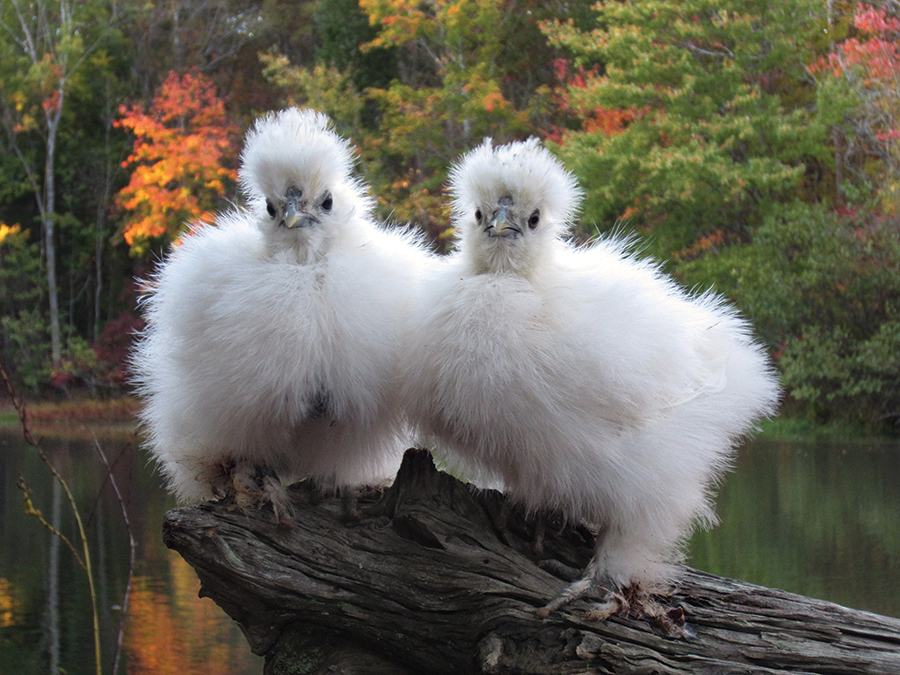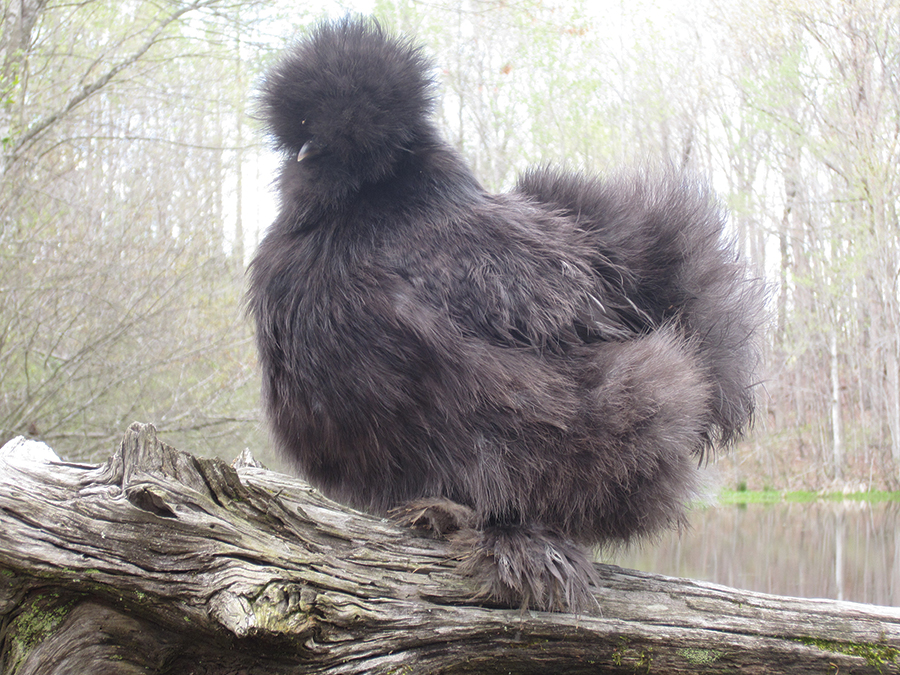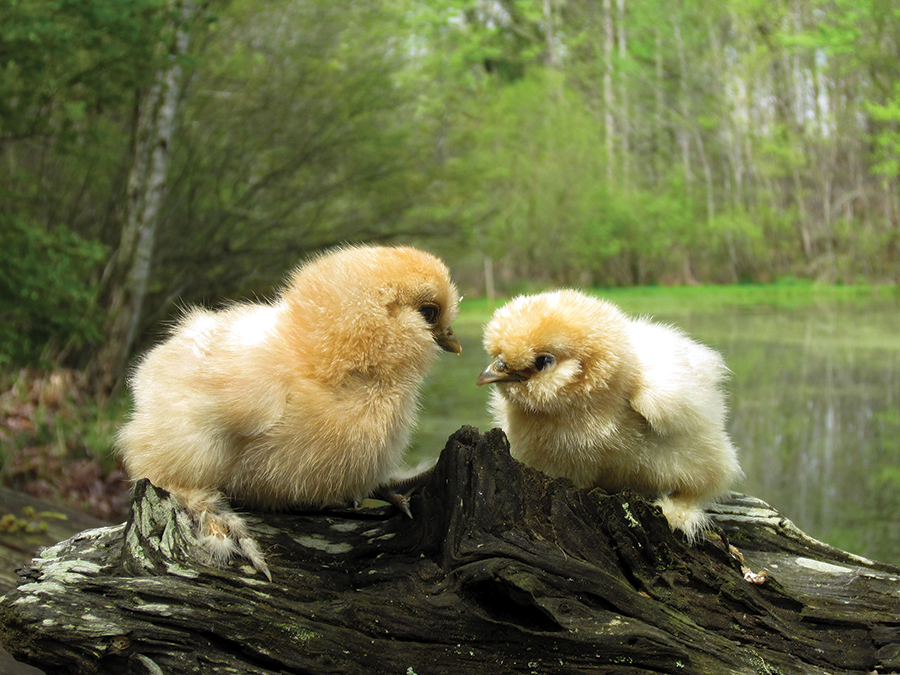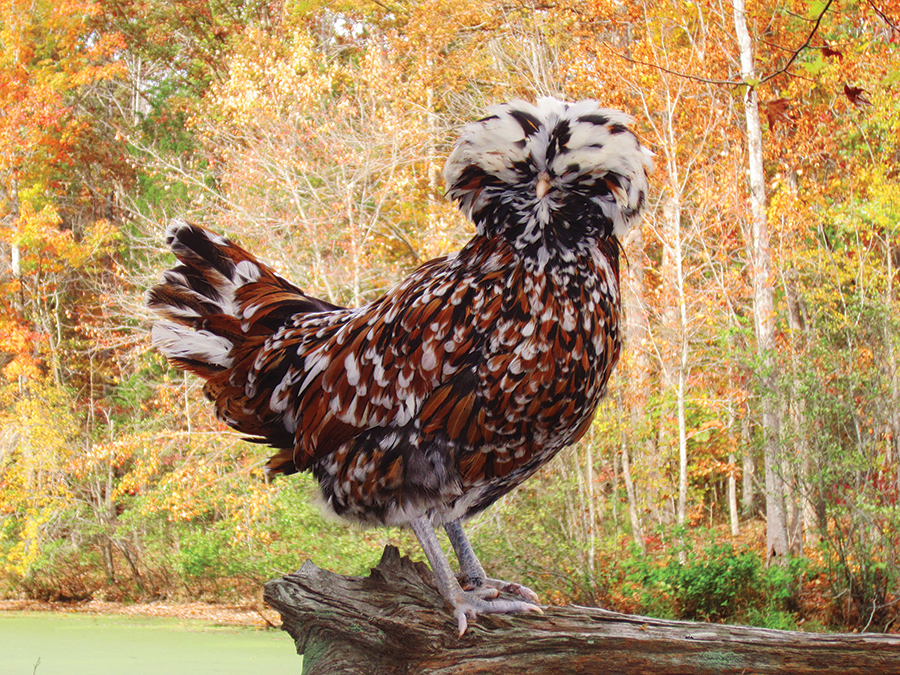
With a wing and a prayer, you too can become a chicken tender
By David Claude Bailey
Photographs by Amy Freeman & Randall Dawson

So you think you want chickens?
So did we years ago when we left Chapel Hill to become hippie farmers on an acre of land in Pfafftown, a bump in the road north of Winston-Salem. Just as I had realized I wasn’t cut out to be a Greek professor, I quickly figured out I wasn’t very good at being either a hippie or a farmer. Still, our little acre was soon home to way too many chickens, ducks, geese, rabbits and one goat by the name of Lucy, named after John Donne’s patroness, the Countess of Bedford. Oh, and innumerable mice. My wife, Anne, remembers our having 59 different (domestic) animals. Or maybe 59 animals had us.
So here’s Chicken 101, lesson learned No. 1: A few chickens, maybe even a pair, are plenty to begin with.
Mind you, my history with chickens goes back to when I was 5 or 6 and my daddy, who was raised on a farm, would inevitably bring home baby chicks at Easter. I loved my roosters and they seemed to love me as they came running up as soon as I sprang out the screen door to spend another day terrorizing the neighborhood. So what if I didn’t notice they really wanted to fight instead of being cuddled? And, yes, inexplicably to me at the time, the roosters would disappear, one by one, as soon as they started crowing and, lo and behold, about the same time they vanished, my mom would cook up some of her ineffable chicken and dumplings.
“Sex Link Hens, $1 a piece,” the hand-painted sign on the road to Pfafftown said, and soon my wife, Anne, and I were tending half a dozen chickens in an advanced state of molt, which is why the farmer had sold them in the first place. Duh! Yes, we were dumb clucks when it came to chickens, and there was no purinamills.com to tell us: “Birds may stop laying farm fresh eggs, lose old feathers and experience feather regrowth. This annual vacation from egg laying is called molt.” Picture a chicken who has weathered a tornado only to be struck by lightning.
So here’s the lesson No. 2 of Chicken 101: Don’t buy molting hens, and don’t panic when three-quarters of your chickens’ feathers fall out and your kids stop wanting to have anything to do with them. The feathers will grow back and the hens will start laying eggs again — until they become broody.

What is a broody hen? “You know you have a broody hen,” say the Purina chicken-chow people, “when she decides to sit on a clutch of eggs day and night. Hens go broody because hormones drive them to hatch chicks, even when the eggs are not fertilized.”
Hormones must have driven our Old English game fowl and the golden Sebright bantams to hide their nests in the woods. They also flew up into tall cedar trees each night to roost. I still itch all over whenever I recall shinnying up the skinny cedar as needles rained down into my clothes. But how else was I going to nab several of the hens to confine them for their laying-in?
Chicken 101, lesson learned No. 3: Making a hen house so chickens can’t get out doesn’t mean snakes, possums, raccoons and, worst of all, skunks won’t get in, eating first the eggs followed by the hens. And while I’ve got your attention, lesson learned No. 4: Never use a Havahart trap if you have skunks.
We took a break from chickens while we raised our own young’uns, and, if you omit poulet à la diable, pollo alla cacciatora and cock-a-leekie, our next encounter with chickens was decades later in Sunset Hills.
In order for our daughters to attend Kiser and Grimsley, we bought the lowest-priced house we could find in the neighborhood. Some houses are fixer-uppers. Ours was a tearer-downer, but we had great neighbors on all sides. Back when the urban chicken thing was just gaining momentum, our very next door neighbors converted their very nice garage into an even nicer chicken coop. The next week, a shipment from MyPetChicken.com arrived — a little FedEx box that cheeped loudly and from which three of the cutest balls of fluff you’ve ever seen emerged. They blinked. They peeped. They walked funny. They tried to fly with wings way too small. Our neighbors’ children loved them and spent quality time cuddling them — until they didn’t. Which, in my humble opinion, is the way most PetChicken experiences end. Chickens, after all, “are descended from a group of two-legged dinosaurs known as theropods, the members of which included the powerful predator Tyrannosaurus rex and the smaller velociraptors.” That, according to a British poultry paleontologist.
Chicken 101, lesson learned No. 4: It’s not for nothing that people use the term “bird brain.” Keep in mind that a chicken’s brain is a tad bit larger than its eyeball. Baby chicks are cuddly and cute and lovable. Adult chickens? Not so much. Chickens are not like dogs or cats or even hamsters in the way they bond with people — or don’t. Fowl defenders say chickens are as smart (in some ways) as a 4-year-old child. I say that depends on the 4-year-old.

Thoughts of chickens never entered my brain until COVID came along, but Anne had been yearning to return to chicken wrangling for ages. We were both retired by then and had moved to a place in the country near Alamance that had a number of outbuildings, one of which was a smokehouse. I had visions of country ham and sides of bacon hanging from the rafters. Anne saw live chickens roosting on perches. You can guess who prevailed.
What may have triggered her decision was what I call Dandy Dawson’s Chicken Ranch and Spa in Asheboro, owned and operated by my hiking buddy, Randall Dawson. Randall caught the chicken bug decades ago, read everything he could get his hands on about show chickens and ordered pedigreed stock that, over the years, took home a number of blue ribbons from local shows. He’d built several coops for these beauties, while others of his chickens and guineas free-ranged over his property. Fearing Anne would soon build a flock of 50-some chickens à la Pfafftown, I negotiated with Randall the “rental” of three iridescent French black copper maran hens, which were, as Randall insisted, the layers of James Bond’s favorite eggs. They were magnificent birds. They strutted and preened and laid eggs regularly, but “they gave me the stink eye,” Anne told Randall. “They don’t like me and I don’t like them. I want friendly chickens,” she said.
Our chicken whisperer suggested that Anne order some cochin bantam eggs. He’d put them under his own cochin bantam, which had just turned broody and has since assumed the role of Mamma Cochin chez nous. If Anne wanted friendly pet chickens, cochins would be ideal, our poultry consultant told us, but they needed to be hand-raised and hand-fed; picked up and fussed over.
That’s how we found ourselves near Sanford one afternoon driving down Round Fish Drive to the home of the Crazy Glamorous Chickens Farm. From the online CGCF egg store, we mooned over photos of some very strange chickens, some of which looked as if they’d been hatched on another planet: magnificent bobtail bantams, showy mille fleurs (aka millies), buff silkies and handsome calico cochins. We ended up with six calico eggs, which we had to pick up in person because a heat wave made shipping perilous. We took the eggs straight to Dandy Dawson’s, where Pappa Randall tucked them under Mamma Cochin. In three weeks, we brought Mama Cochin and her brood of only two chicks to the Smokehouse Chicken-and-So-Much-More Compound. (The other eggs didn’t hatch, maybe because of the heat wave.) Six chickens seemed ideal to me but when I made the mistake of going sailing one weekend, I came home to a flock supplemented with two mille fleurs acquired from Happily Feathered Farm in Mooresville.
At this point I exercised my money-back guarantee and took the marans back to the ranch. “No fowl,” Randall said. (In fact, no money was ever exchanged. I paid for the chickens with bottles of gin and scotch.) Inevitably our tiny flock of five was hit by tragedy: For no apparent reason one of Mamma Cochin’s brood, a cockerel named Zorro, just up and died, as chickens will. He was a handsome lad whose portrait was painted by no less than Chip Holton, O.Henry Hotel’s artist in residence. But as we all know, the good die young.
Chicken 101, lesson learned No. 5: It’s best not to name your pet chickens, but how can you resist as their buffoonery and misdemeanors mirror those of your friends and colleagues?

Over the next year, Goldilocks and Mamma Cochin raised six new chicks, which Anne also hand-patted, hand-fed and, yes, named — Dotty, a mottled blue-black pullet, and her tall sister without spots, Cher. There was also Serenissima, the runt, sweet but a little dumb. Finally a hen that pecked the others and was perpetually disgruntled. We called her alternately Karen or Cruella.
Anne doted on her hens and they doted on her. To this day, Goldilocks, Anne’s favorite, refuses to fly up onto her perch at night, waiting for Anne to pick her up, whisper sweet nothings into her ears and put her in her accustomed spot.
Chicken 101, lesson learned No. 6: If you want chickens to love you, you have to love them.
And then there were the roosters — Dapper Dan, Vlad, Gray Bar and Silver Neck. Although Dapper Dan, who had developed a really long and sharp set of spurs, was definitely the alpha male, that didn’t keep the other cocks-of-the-walk from hourly challenging him and each other. They will fight to the death if you don’t separate them, though our chicken expert insists that they’ll establish a pecking order if you just leave them alone. Easy to say. Hard to do. Two of the new cockerels suddenly decided humans needed to be put in their place. We remembered that our friends in Chapel Hill incurred hundreds of dollars worth of medical bills when their rooster attacked a friend, so we knew we had to thin the flock, which numbered ten chickens. Oh, by the way, by then two hens were sitting on — wait for it — 19 eggs.
So how do you eliminate three roosters that look at you as if you’re their momma and eat out of your hand? Cook them? “Heavens, no!” said Anne. (Besides, I never, ever want to pluck another chicken.) Sell them? No way, since anyone else with chickens has a rooster surplus. Give them to city slickers? Nope, roosters are unlawful in Greensboro and a lot of other cities. We discovered that what savvy chicken farmers do is sell pairs. If someone wants a hen, great, but each hen comes with a rooster. Once we realized we would have to part with some of our hens, we were able to find a nice buyer for two of our pairs.
So the Chicken 101, lesson learned No. 7 is the toughest yet: Sooner or later you will have more chickens than you want or can keep. It’s a sticky situation once you get there, so make a plan ahead of time and stick to it.
Epilogue: Of the 19 eggs under the two hens, eight hatched. Immediately Goldilocks and Karen started fighting over whose chicks were whose, abandoning, Deo gratias, the other eggs. One of the baby chicks had to be “re-lived” as our neighbor in Pfafftown called it. And on Mother’s Day, Anne fed her ailing little chick with an eye dropper, cuddling it and warming it up in a shoe box. Now it struts with the best of them.
Dapper Dan had a recent close encounter with a coyote, but survived. The flock size, admittedly, has swollen to 14. Karen and Graybar are currently being marketed. Others will follow.
So you think you want chickens?
We got ’em. $10 a pair! OH
David Claude Bailey, a contributing editor to O.Henry, spends his days growing tomatoes, counting chickens and fixing other people’s grammar.





